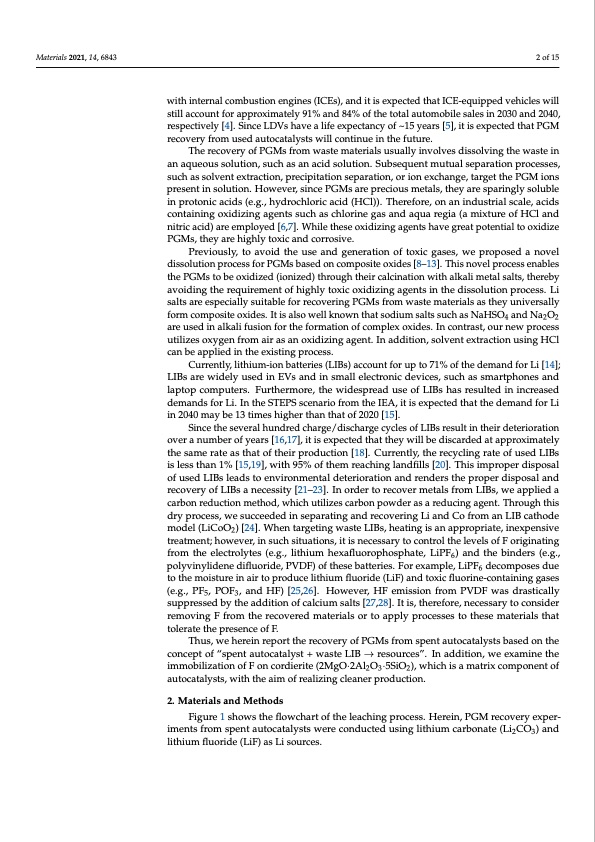
PDF Publication Title:
Text from PDF Page: 002
Materials 2021, 14, 6843 2 of 15 with internal combustion engines (ICEs), and it is expected that ICE-equipped vehicles will still account for approximately 91% and 84% of the total automobile sales in 2030 and 2040, respectively [4]. Since LDVs have a life expectancy of ~15 years [5], it is expected that PGM recovery from used autocatalysts will continue in the future. The recovery of PGMs from waste materials usually involves dissolving the waste in an aqueous solution, such as an acid solution. Subsequent mutual separation processes, such as solvent extraction, precipitation separation, or ion exchange, target the PGM ions present in solution. However, since PGMs are precious metals, they are sparingly soluble in protonic acids (e.g., hydrochloric acid (HCl)). Therefore, on an industrial scale, acids containing oxidizing agents such as chlorine gas and aqua regia (a mixture of HCl and nitric acid) are employed [6,7]. While these oxidizing agents have great potential to oxidize PGMs, they are highly toxic and corrosive. Previously, to avoid the use and generation of toxic gases, we proposed a novel dissolution process for PGMs based on composite oxides [8–13]. This novel process enables the PGMs to be oxidized (ionized) through their calcination with alkali metal salts, thereby avoiding the requirement of highly toxic oxidizing agents in the dissolution process. Li salts are especially suitable for recovering PGMs from waste materials as they universally form composite oxides. It is also well known that sodium salts such as NaHSO4 and Na2O2 are used in alkali fusion for the formation of complex oxides. In contrast, our new process utilizes oxygen from air as an oxidizing agent. In addition, solvent extraction using HCl can be applied in the existing process. Currently, lithium-ion batteries (LIBs) account for up to 71% of the demand for Li [14]; LIBs are widely used in EVs and in small electronic devices, such as smartphones and laptop computers. Furthermore, the widespread use of LIBs has resulted in increased demands for Li. In the STEPS scenario from the IEA, it is expected that the demand for Li in 2040 may be 13 times higher than that of 2020 [15]. Since the several hundred charge/discharge cycles of LIBs result in their deterioration over a number of years [16,17], it is expected that they will be discarded at approximately the same rate as that of their production [18]. Currently, the recycling rate of used LIBs is less than 1% [15,19], with 95% of them reaching landfills [20]. This improper disposal of used LIBs leads to environmental deterioration and renders the proper disposal and recovery of LIBs a necessity [21–23]. In order to recover metals from LIBs, we applied a carbon reduction method, which utilizes carbon powder as a reducing agent. Through this dry process, we succeeded in separating and recovering Li and Co from an LIB cathode model (LiCoO2) [24]. When targeting waste LIBs, heating is an appropriate, inexpensive treatment; however, in such situations, it is necessary to control the levels of F originating from the electrolytes (e.g., lithium hexafluorophosphate, LiPF6) and the binders (e.g., polyvinylidene difluoride, PVDF) of these batteries. For example, LiPF6 decomposes due to the moisture in air to produce lithium fluoride (LiF) and toxic fluorine-containing gases (e.g., PF5, POF3, and HF) [25,26]. However, HF emission from PVDF was drastically suppressed by the addition of calcium salts [27,28]. It is, therefore, necessary to consider removing F from the recovered materials or to apply processes to these materials that tolerate the presence of F. Thus, we herein report the recovery of PGMs from spent autocatalysts based on the concept of “spent autocatalyst + waste LIB → resources”. In addition, we examine the immobilization of F on cordierite (2MgO·2Al2O3·5SiO2), which is a matrix component of autocatalysts, with the aim of realizing cleaner production. 2. Materials and Methods Figure 1 shows the flowchart of the leaching process. Herein, PGM recovery exper- iments from spent autocatalysts were conducted using lithium carbonate (Li2CO3) and lithium fluoride (LiF) as Li sources.PDF Image | Recovery of Platinum Group Metals from Auto Catalysts

PDF Search Title:
Recovery of Platinum Group Metals from Auto CatalystsOriginal File Name Searched:
materials-14-06843-v2.pdfDIY PDF Search: Google It | Yahoo | Bing
Product and Development Focus for Salgenx
Redox Flow Battery Technology: With the advent of the new USA tax credits for producing and selling batteries ($35/kW) we are focussing on a simple flow battery using shipping containers as the modular electrolyte storage units with tax credits up to $140,000 per system. Our main focus is on the salt battery. This battery can be used for both thermal and electrical storage applications. We call it the Cogeneration Battery or Cogen Battery. One project is converting salt (brine) based water conditioners to simultaneously produce power. In addition, there are many opportunities to extract Lithium from brine (salt lakes, groundwater, and producer water).Salt water or brine are huge sources for lithium. Most of the worlds lithium is acquired from a brine source. It's even in seawater in a low concentration. Brine is also a byproduct of huge powerplants, which can now use that as an electrolyte and a huge flow battery (which allows storage at the source).We welcome any business and equipment inquiries, as well as licensing our flow battery manufacturing.| CONTACT TEL: 608-238-6001 Email: greg@salgenx.com | RSS | AMP |